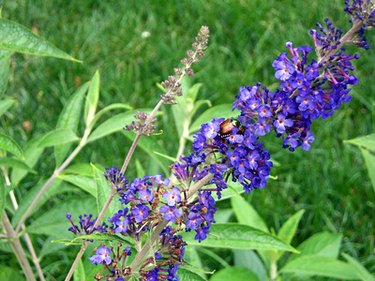
Butterfly bush (Buddleia) is a popular deciduous shrub that was introduced into the United States from China. The plant begins producing flowers in early to mid-summer and continues blooming until frost. As its name suggests, the 6- to 12-inch-long blossoms are known for attracting multitudes of butterflies. Although butterfly bush is easy to care for and typically remains free of disease problems, some pests may find it appetizing.
Deer
Video of the Day
Deer eat vegetation, and hungry deer are not particular as to what type. The Rutgers New Jersey Agricultural Experiment Station rates butterfly bush as a plant that is rarely damaged by deer. It is considered to be "deer resistant." Keep in mind that no plant is deer proof. Buddleia is simply less palatable to them than other shrubs. Certain conditions, such as snow cover, may cause deer to eat plants they normally would not forage. Determining if it is deer that are eating your butterfly bushes requires that you first examine the area around the damaged shrub for evidence of tracks or excrement droppings. Also, look at the type of damage caused. Deer do not possess upper front incisors. As a result, they tear the plant as they eat it, leaving jagged edges. Damage can occur anywhere from ground level to a height of 6 feet.
Video of the Day
Rabbits and Woodchucks
Like deer, rabbits and woodchucks eat vegetation and are not particularly fond of butterfly bush. Even though it is a plant that is listed as being rabbit resistant, it will be consumed if conditions warrant. Again, tracks and droppings in the area provide important clues as does the appearance of the damaged shrub. Rabbits will gnaw the plant's older woody growth leaving .08 inch teeth marks. Rabbits and woodchucks have both upper and lower front teeth allowing them to neatly sheer off young stems and buds. Damage is observed at a height of 2.5 feet above the ground.
Caterpillars
Even though the purpose of planting butterfly bushes is to attract butterflies, the larval form of some butterflies and moths can be detrimental to Buddleia. The caterpillar of the checkerspot butterfly and the Genista caterpillar are documented insect pests of this particular shrub. Checkerspot butterfly caterpillars are large, hairy, bluish-black in color and have small orange spots. They do their damage by chewing holes in the plant leaves. Genista caterpillars are approximately 1 inch long, green to orange in color and possess black and white hairs. They feed on the new growth that emerges in the spring. They spin webs and defoliate the bush. This caterpillar eventually develops into a small brown moth. Genista caterpillars are far less likely to infest Buddleia than those of the checkerspot butterfly.
Japanese Beetles
The Japanese beetle measures 1/2-inch long and is metallic green with a copper-colored back. Their larvae exist in the soil as grubs and emerge as beetles at the end of June or early in July. Japanese beetles can do extensive damage to butterfly bushes, eating in and around the leaves, frequently leaving only a venous skeleton.
Twospotted Spider Mites
The twospotted spider mite measures 1/50-inch long and is oval in shape. Its color varies and can be brown, orange-red, green or greenish-yellow. In some cases it is almost translucent, revealing the body contents inside, which appear as large dark spots. The mites are found on the underside of the leaves and cause them to turn yellow and develop dead spots. These pests are named as such because they spin webs on the host plant, the presence of which aids in their identification.